I wrote a book called Unknown Legends of Rock’n’Roll. I could also write a book called Urban Legends of Rock’n’Roll, meaning those myths about rock history that get perpetuated so often that they’re often repeated as fact. Some of these are major—that rock’n’roll died between Buddy Holly’s death and the arrival of the Beatles in the US, for instance, or that the Beatles failed their Decca Records audition because they were forced to play popular standards (though those comprised only four of the fifteen songs on their audition tape). Maybe the myth addressed by this post will be considered minor in comparison. But the matter of what one side of the Who’s first single was based on is usually misreported, and has become an unusually persistent error.
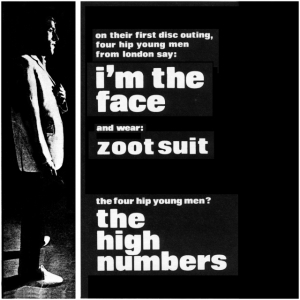
Advertising for the Who’s first single, though they were billed as the High Numbers when “I’m the Face” and “Zoot Suit” were paired on a July 1964 single.
Here’s the basic genesis of the story: in mid-1964 the Who, who had briefly changed their name to the High Numbers, recorded their debut single. Released on July 3, 1964, it featured two songs bearing the songwriting credit of Pete Meaden, a mod then involved in the group’s management. These were, however, in fact blatant rewrites of American blues and soul songs, putting rather contrived—borderline exploitative, even—lyrics celebrating the mod lifestyle to note-for-note copies of US records.
The more famous of the two sides is “I’m the Face,” owing to its wider availability (as it was first reissued as part of the Who’s 1974 Odds & Sods compilation) and having sometimes been reported as being the A-side. (In another mini-myth, as the inner label of the original 45 makes clear, it was the B-side, not the A-side.) The source of the tune is obvious: it’s based on the great Louisiana bluesman Slim Harpo’s “Got Love If You Want It,” using a very similar melody and shuffling, irregular rhythm. Though not exactly famous, the song would have been well known to London R&B aficionados by mid-1964—the Yardbirds, with Eric Clapton, had already recorded it for their first LP (though it wouldn’t come out until December), and the Kinks put a cool raveup version on their first LP (released in October).
The other side of the 45—officially, the A-side, though it’s often reported as the flip—was “Zoot Suit,” which had a much more unusual, winding minor melody. Many sources, such as the first big Who biography (Dave Marsh’s Before I Get Old, from 1983), report that this is a cover of “Country Fool,” the B-side of the Showmen’s small 1961 US hit “It Will Stand.” (Note, too, that although “It Will Stand” would soon become revered as one of the greatest odes to rock’n’roll, it was a small hit at the time of its release, not a big one, peaking at #61 in the national charts.) This is also stated in the most recent notable Who book, the excellent Pretend You’re in a War: The Who & the Sixties (2014), in which author Mark Blake writes that “the B-side, ‘Zoot Suit,’ was another Meaden-composed mod anthem, based on the song ‘Country Fool’ by the New Orleans doo wop group the Showmen.”
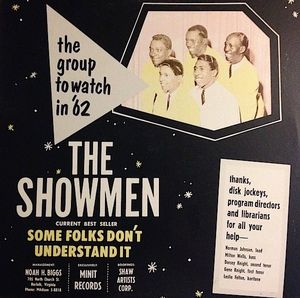
Although this ad for the Showmen, oddly, doesn’t name either of the songs on their “It Will Stand”/”Country Fool” single, it prominently quotes a lyric from “It Will Stand”—”some folks don’t understand it” (meaning those adults who slagged rock’n’roll in its early days).
Since it was the B-side of a hit record that proved unusually durable on oldies radio for many years despite its modest initial chart placing, “Country Fool” has never been hard to find. And in 2015, it’s really easy to find—online, if you must, though it’s come out on several CDs, including the superb four-CD compilation Crescent City Soul: The Sound of New Orleans 1947-1974 (which also includes “It Will Stand”). Even these liner notes add to the chorus of confirmations that “Country Fool” was turned into “Zoot Suit” by the Who/High Numbers, Alan Warner writing that “the rambunctious ‘Country Fool’ was sabotaged in 1964 as ‘Zoot Suit’ by a British group called the High Numbers, who would later find fame as the Who.”
But guess what? “Country Fool” doesn’t sound like “Zoot Suit.” Play the two songs back-to-back if you don’t believe me.
And guess double what? Play the Dynamics’ “Misery,” which almost made the US Top 40 (peaking at #44, and reaching the Top Ten in their native Detroit) in late 1963. Except for the lyrics, it sounds exactly like the Who’s “Zoot Suit.”
(It’s on at least a couple CD compilations if you want a hard copy, incidentally, including The Big Top Records Story: Classic New York [sic] Pop 1958-1964. “Misery” is also correctly cited as the source for “Zoot Suit”‘s tune in the revised 2005 edition of Andy Neill and Matt Kent’s excellent Anyway Anyhow Anywhere: The Complete Chronicle of The Who 1958-1978.)
How could such an obvious mistake have been made—and how can it continue to be made—about who the Who were essentially “covering” on “Zoot Suit” for more than 30 years now? The source turns out to be the “writer” of “Zoot Suit” himself.
For on November 17, 1979, the New Musical Express ran an interview with Pete Meaden (conducted by Steve Turner) in which he was asked about “Zoot Suit.” (Meaden died in July 1978, but the two interviews combined in the NME piece were done shortly before his death.) His response was quite thorough, if in part inaccurate:
“‘Zoot Suit’ was the fashion record of all time—it pinched the backing track of ‘Country Fool’ by the Showmen, which was the B- side of ‘It Will Stand.’ The Showmen are now known as Chairmen Of The Board and ‘It Will Stand’ is the rock’n’roll tribute anthem of all time. I heard the melody, and the night before the session I dreamt up the lyrics, and I wrote them all down—I wrote them down on speed. The actual words were ‘I’m the hippest number in town, And I’ll tell you why’ and it goes on to ‘I wear a Zoot Suit jacket with side-vents five inches long’ and it’s a great song, man…”
Meaden—who, as even that quote confirms, was a heavy amphetamine user, and a patient in a mental hospital when Turner tracked him down in 1975—must have been misremembering the single he’d “pinched.” Obscure US soul singles were almost as prized as pills on the London mod scene, and Meaden must have owned or had access to the 45 of the Dynamics’ “Misery.”
And who were the Dynamics? There’s an amazing amount of detail about the original record, and the Detroit soul group that cut it, on this page on the Michigan Rock and Roll Legends site. This article poses this challenging question: “If Meaden simply rewrote the words, shouldn’t one or both of these songwriters be getting credit for the melody?”
Interestingly, the songwriting credit on the Dynamics’ “Misery” goes to their manager (George “Ernie” Stratton) and voice coach (Anthony Wilson). Yet this article also states that original Dynamics member Fred “Sonny” Baker “said that somehow the credits were listed incorrectly on the record labels resulting in their manager and vocal coach being given undeserved songwriting credits on both sides of the single. Baker vows that he and Warren Tippett wrote ‘Misery.’”
Were the Who aware of any of this when they recorded “Zoot Suit” back in June 1964? Probably not. And the Dynamics almost certainly weren’t either, since “Zoot Suit”/“I’m the Face” was a flop, Accounts of exactly how many copies it sold vary, but total certainly failed to even reach four figures. Only a thousand copies were pressed, and Meaden told Steve Turner that “I bought 250 records off the record company, off Fontana, to get it into the charts.”
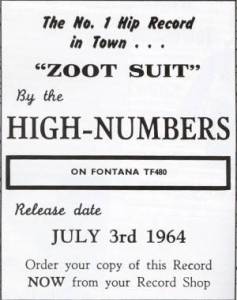
An ad for the High Numbers single offers more confirmation that “Zoot Suit” was the A-side, as it’s the only song plugged, and “I’m the Face” isn’t mentioned.
So next time you see “Zoot Suit” described as a rewrite of “Country Fool”—and there probably will be a next time, given how many times it’s been reported as such—be aware that the true source was something quite different. And quite cool—“Misery” is a pretty nifty 45, in large part due to that odd winding minor melody. And even if the rewrite wasn’t all that kosher, “Zoot Suit”’s a pretty cool record too—if nowhere near as distinctive and original as the record that would launch the Who into the British charts in early 1965, the Pete Townshend-penned “I Can’t Explain.”

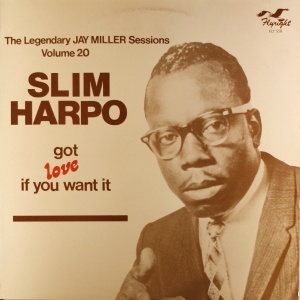
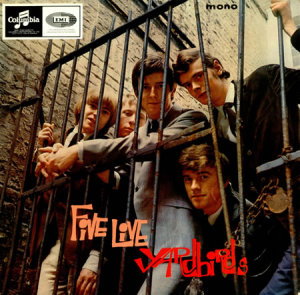
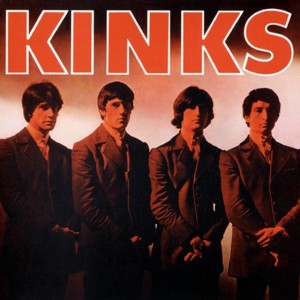
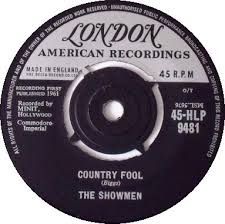
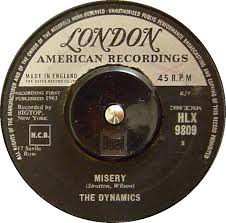
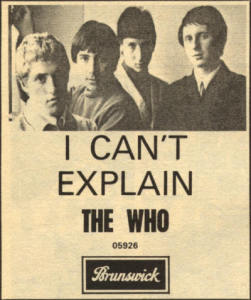
Excellent !
Well done Richie, and thank you for the explanation. 😉